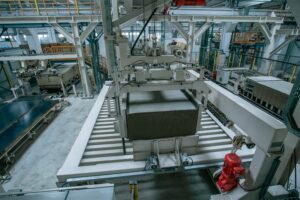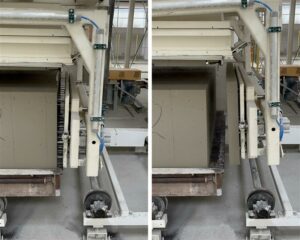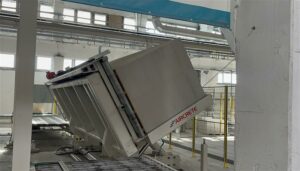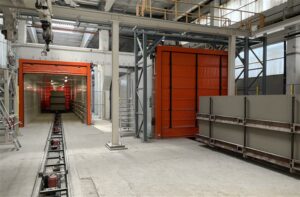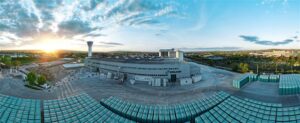The construction sector of the Romanian market has long been pivotal in the nation’s economic landscape, contributing to the nation’s growth and development. However, it faces a complex interplay of challenges that demand innovative solutions. The shortage of skilled labour, coupled with fluctuating skillsets, hinders the sector’s growth potential. Moreover, environmental awareness and sustainability aspirations demand adherence to strict standards. According to the European Commission [1], the Romanian construction market confronts labour shortages in the construction industry, particularly stemming from, but not limited to, low wages and emigration. These shortages pose potential hindrances to sector recovery and expansion. In a construction climate where safety, efficiency and sustainability are paramount, automated production rises as a transformative solution. By shifting towards automated production, Romania can alleviate its labour shortage, reduce its environmental footprint, and enhance quality assurance standards.
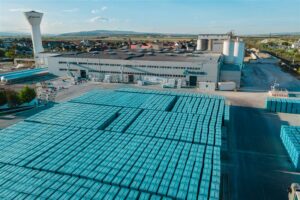
AAC in Romania
In the beginning of the 1970’s, AAC started gaining prominence in Romania, aligning with a growing awareness of faster, more sustainable construction practices and the need for more energy-efficient buildings. Since then, Romania has become one of the most AAC penetrated markets in the world, with total national installed capacity of more than 3,000,000 cubic meters annually. Part of the total installed capacity is being exported to the neighbouring countries with lower capacities, like Moldova and Bulgaria.
The factory in Adjud, owned by the Holcim Group since 2019, that was originally built with Hebel-based technology in 1975 and, is one of the larger AAC producers of the AAC in Romania. Over time, the factory was facing the inevitable challenge common for all older production facilities – it needed to adjust for the modern market demand: enhanced energy efficiency, optimized production processes, improved personnel safety situation and minimization of ecological footprint. In 2023, Aircrete Europe has completed a major modernization of the old Hebel plant, introducing higher capacity, higher automatization, improved safety situation and lower product waste rates, at the same time launching Holcim’s Performo AAC, as the product was rebranded from Somaco in 2023. (Fig 1.)
“Holcim is making its contribution to building greener cities, by making investments that would allow the production of building materials that improve energy consumption, reduce the use of resources, have a low impact on nature, and transform buildings into more sustainable spaces. The Performo AAC and the powerful thermo-insulating masonry system
created by Holcim are proof of our commitment to transforming our products into solutions that foster the development of the built environment in harmony with nature. We are constantly making investments, developing and launching new products, to make sure our customers are certain of the performance and sustainability of our products” – Bogdan Dobre,
CEO of Holcim Romania and Market Head Moldova, on Business Review [2]
Project design
In a bid to adapt to growing industry standards and meet the demands of the changing market, Aircrete embarked on a transformative journey of modernization of the aging plant. The project aimed to enhance the production capacity, streamline its processes to minimize waste, and harness the power of increased automatization to increase operational efficiency. These pivotal upgrades not only breathe new life into the facility but also position it to remain a competitive player in the industry, catering to the growing demand for environmentally conscious and efficient construction materials.

The increase of production capacity of the old plant was not possible with the original configuration of equipment – number of moulds, cutting line cycle and autoclaving capacity could not had given the room for higher production rates. As a supplier of modern flat-cake technology, Aircrete conducted a thorough analysis of the entire plant layout to determine what areas were to be modernized. The big challenge was to achieve the substantial increase in capacity within the existing building as well as implementing the modernization with a minimal shutdown time of the running plant. A major structural change in the layout was the conversion from the traditional, static, mould situation (typical for factories build in Romania in the past) to the Aircrete flexible mould circulation system where the moulds move around on the so-called roller-tracks. Another major advantage of using these roller tracks is no big overhead crane is required (as was the case in the original setup) and no foundations are required either (as opposed to using rails), making them very easy to install, align and maintain. Part of the scope was the supply of new moulds, with an increased height so cakes up to 650mm (net) in height (i.e. the length of the AAC block) can be produced.
Fig. 3: The new rising area has been covered and fully-equipped with a flexible roller track system
Project scope
In principle one can say, that Aircrete supplied almost a complete new plant into the existing building as only the silos and part of the mixing tower and the autoclaves remained of the old plant. As any AAC production starts at raw materials preparation and mixing, this article begins with the journey of the upgrade of the ball mill. During the project, the two smaller old ball mills were replaced with one large ball mill. The brand new Aircrete mixer, equipped with the automatic high-pressure cleaning system to minimize cleaning and manual intervention, was installed to reduce the requirement for manual cleaning and the cycle time of mixing, thereby increasing the overall production safety and efficiency. The Aircrete mixer has been equipped with the latest generation mixer outlet with a unique design and highly flexible valve control system to avoid the wash away of oil while not compromising on cycle time at the same time. In addition, in line with the global trend to switch from the use of aluminium powder to paste in AAC production, the old aluminium powder system was replaced by the newly designed Aircrete Aluminium Paste Dosing System, for more precise and safe way of dosing aluminium. The new Aluminium Paste Dosing System is a standalone machine, with two storage bins and a unique dosing mechanism that allows for very high dosing precision of one or two different types of aluminium paste. The new Aluminium Paste Dosing System has proven itself to be even more effective in practice than on paper, and Aircrete anticipates its continued effectiveness for many years to come.
Fig. 4: The new Generation Aircrete Aluminium Dosing System
The new Aircrete moulds also created the opportunity to install additional automation features, like the automatic mould door latching and unlatching and automatic mould door opening and closing. These automations resulted in an improved cycle time with less manual invention, therefore further contributing to the overall personal safety in the plant as well. The Aircrete system with opening mould doors provides a big advantage when it comes to cleaning. As the mould doors fully open on all sides to a complete flat surface, the mould is easy to clean before it is being oiled, thereby optimizing the oiling of the moulds which reduces the change of sticking and other quality issues in the production process.
Fig. 5: A green cake being ready to be cut on the Aircrete Separate Cross Cutter
The cutting area is the heart of any Aircrete plant. Performo AAC was supplied with the latest version of the Aircrete Super Smooth Flat-cake cutting line. To offer the most sustainable and precise cutting and to ensure a significant increase in production volume, the cutting line was equipped with the new Aircrete Separate Cross Cutter. After the cake is ready for cutting, the mould is brought by a traverser car and roller tables to the mould opening position. Here, the mould fully opens, and the grabbing manipulator picks up the green cake to bring it to the Separate Cross Cutter. With shorter wires than the original Aircrete Cross Cutter (which is integrated in the first section of the Aircrete Traditional Flat-Cake Cutting Line) and lamellas to compact the blocks without putting force, the cross cut of the cake takes place.
The programmable speed of frame allows the new Aircrete Cross Cutter to fit the factory cycle flawlessly as well. After the cross cut, the grabbing manipulator brings the cake to the next section of the cutting line where the horizontal cut is being made to determine the height of the cake (i.e. length of the AAC blocks) and the vertical cut to determine the thickness of the AAC blocks with super smooth surfaces (through the use of double-wired oscillating cutting technology at high speed).
Fig. 6: The view on the Aircrete Separate Cross Cutter (where the lamellas can be seen as well). In the background the green cake (with the cross cut) has been positioned on the next section of the cutting line.
After the cake has been fully cut, the cake travels to the next station, where the top crust is being removed with a vacuum hood. For the side crust, Aircrete uses a different solution: the Needle-plate End-hood Removal System. As the uniformity of the surface of the front and back crust could be compromised (e.g. due to corner damages to the waste crust), removal by vacuum might not work ideal. Instead, with the new Needle-plate End-hood Removal System, a movable needle plate with needles (that move through another plate with holes) penetrate
the front and end crust of the green cake and, without suction force, the needles hold the crust of the green cake and move it to the crust pit area. There, the needles retract from the crust and the crust is dropped in the crust pit. This solution has proven to be very efficient and successful and has yet been implemented at many other Aircrete clients around the world.
A newly designed frame circulation resulted in the supply of new curing frames, new curing frame cars conveying system, new frame manipulators and, finally, the new fully automatic autoclave traverser car with two autoclave trolley positions. On top of the improved frame circulation situation, the downtime of the plant was efficiently used to install two additional autoclaves. Due to the layout of the plant and the proximity of the existing plant to the edges of the land plot, the two additional autoclaves where installed at 180° (so in the exact opposite) to the existing ones. This resulted in a specially-designed autoclave traverser with two directional push-pull and, in addition, with the special capability to be able to load two stacks of cakes at the same time on it. A further optimization to optimize the production process and minimize the use of energy was the installation by Holcim of special climate-controlled chambers, both at the pre-curing section as well as for the buffering of green cake autoclave buffering.
Fig. 7: The side crust being removed by the Needle-plate End-hood Removal System
Furthermore, an additional frame crane was installed between the unloading area and cutting area, to ensure full production redundancy. In the unlikely event of an issue in the unloading area, the frame crane would ensure continuous supply of frames to the cutting line, so thereby preventing any potential production interruption. All the above upgrades have contributed eventually to a significant increase in total production by more than 30%.
Cornel Banu, Industrial Director Holcim Romania, commented “It was very important to engage an experienced technology partner for this project with ample experience on designing and installing large complex modernization projects like our project. Like for every project, things did not always go according to plan but I am very satisfied with the professional and long-term partnership approach we received from Aircrete and I am very happy with the end-result. The new upgrade with the latest Aircrete technology has made us future-proof again in terms of employee safety, product quality and plant capacity.”
Fig. 8: The tilting table automatically tilts two complete cakes onto six pallets at once.
Project preparation and implementation
Aircrete embarked on a comprehensive modernization project for the aging plant, targeting increased production capacity, reduced waste, improved safety and greater automation. The project involved upgrading various aspects, from raw material preparation to cutting and autoclaving. Aircrete, with its strong history of successful complex modernization projects, understands that careful planning and teamwork are key to a smooth installation that aims to minimize the inevitable downtime. Throughout the engineering and manufacturing phases, Holcim and Aircrete worked together efficiently to remove the old equipment, make necessary changes to the foundations, and install the new Aircrete equipment. Clear roles and responsibilities were crucial for the project’s success. Aircrete isn’t just a machine supplier; it is a long-term technology partner.
Fig. 9: Newly-installed climate controlled chambers to buffer the green cakes before autoclaving.
Aircrete’s commitment to innovation and forward thinking was evident throughout the project. Additionally, a new, more precise aluminium paste dosing
system and a separate cross cutter were introduced to enhance precision and efficiency in AAC block production. These innovations reflect Aircrete’s dedication to providing cutting-edge solutions.
Koen van Boggelen, Operations Director at Aircrete Europe, looks back satisfied on a challenging but very interesting project. “Major upgrades like this project, which result in a complete shutdown of the plant for a longer period of time, are always very challenging to execute and coordinate. Not only do you have to take existing factors like foundations, columns of the building and existing plant layout into account during the engineering phase, but also the downtime of the factory is a critical element during the installation phase. A thorough preparation phase is therefore extremely important and good communication between all stakeholders is critical. Looking back, a big thanks go out to both teams of Holcim and Aircrete for working together in a pragmatic, goal-oriented and professional way and making this project a big success.”
Future steps
Looking ahead, Aircrete remains committed to pushing the boundaries of innovation and sustainability in AAC production. The recent modernization project with Holcim Romania serves as a testament to the company’s forward-thinking approach and its dedication to staying at the forefront of industry developments. As the industry landscape continues to evolve, Aircrete envisions further advancements in automation, precision, and sustainability. These future steps will involve ongoing research and development, with a keen focus on enhancing production capabilities, minimizing waste, and maintaining the highest standards of quality. With a track record of setting new industry benchmarks, Aircrete is poised to shape the future of AAC manufacturing by embracing cutting-edge technologies and sustainable practices.
Fig. 10: The start of a new morning for Holcim Romania, experienced from the raw materials area.





